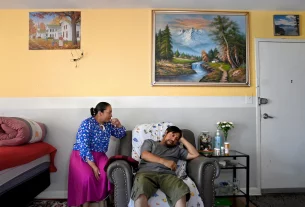[ad_1]
At TV Broadcast Camp, everyone is on deadline. This July, ThreeSixty Journalism students scrambled to write scripts, film interviews and edit the final cut of their stories about health equity before the weeklong camp ended.
ThreeSixty Journalism, a nonprofit journalism training program for marginalized youth, has been running TV Broadcast Camp for five years. In 2017, they partnered with the BlueCross BlueShield Center for Prevention on a mission to empower the future of journalism and change the narrative of health coverage in media.
Gloria Ngwa has been interested in journalism since she was young. She’d watch the news and dream about one day becoming a TV anchor, she said. And her interest in storytelling has only grown.
“When the murder of George Floyd started making headlines, I started to get more passionate about telling stories that are underrepresented, specifically in the Black community,” the high school junior from Washington Tech and Magnet School said.
At broadcast camp, Ngwa worked alongside videographer Ben Garvin and reporter Lindsay Seavert. With their guidance, she produced a story about OutFront Minnesota, an organization serving the LGBTQ community through public policy and education.
The whole experience was entirely hands-on: Ngwa learned how to work in front of the camera as well as how to edit footage and record voiceovers.
“Now that I’ve done TV camp, I can really see myself working for a TV news station in the future,” Ngwa said.
But Ngwa and her peers aren’t the only ones benefiting from TV Broadcast Camp. The program has a dual benefit, said Sasha Houston Brown, senior communications and advocacy consultant for BCBS.
“Not only are we giving young people an immersive journalism experience, but they’re helping us change the narrative and move away from deficit-based narratives that so often define communities of color,” she said.
Houston Brown works with TV Broadcast camp to assign stories about health equity that uplift positivity and progress within marginalized communities. So often, marginalized communities are represented in the media by stories about crime, addiction and violence, she said.
“We want to focus on the community-led resources that are already there, because the communities often hold the solutions and are already implementing them,” Houston Brown said.
The process of story assignments has evolved over the past five years. This year, ThreeSixty students are reporting on organizations that go beyond just the clinical aspects of health.
“This summer, the theme is holistic health, which includes mental health, because we heard from a lot of students that was a huge issue impacting their generation and community. So we’re looking at how gender inequity in school impacts mental health, or how addressing police violence impacts community health,” Houston Brown said.
Many of the students at TV Broadcast camp are part of the communities misrepresented in mainstream media health coverage. But their proximity to their communities’ issues is a strength, Houston Brown said.
“We want to help these students realize how much knowledge they have already just from their lived experiences. I think we often downplay the importance of lived experience in the media and journalism fields, but representation really matters in a newsroom,” she said.
In the U.S., 77% of newsroom employees are white, according to the Pew Research Center. In order to change that, there need to be more opportunities for young people of color to become the journalists who write about their communities’ issues, Houston Brown said.
“It’s the difference between someone who understands the situation and knows what questions to ask versus someone who, even with good intentions, doesn’t understand and can perpetuate really hurtful bias that only reinforces racism,” she said.
Isabel Saavedra-Weis is an alumna of Three Sixty Journalism, a program at the University of St. Thomas that offers journalism training to high school students from marginalized communities.
[ad_2]
Source link


